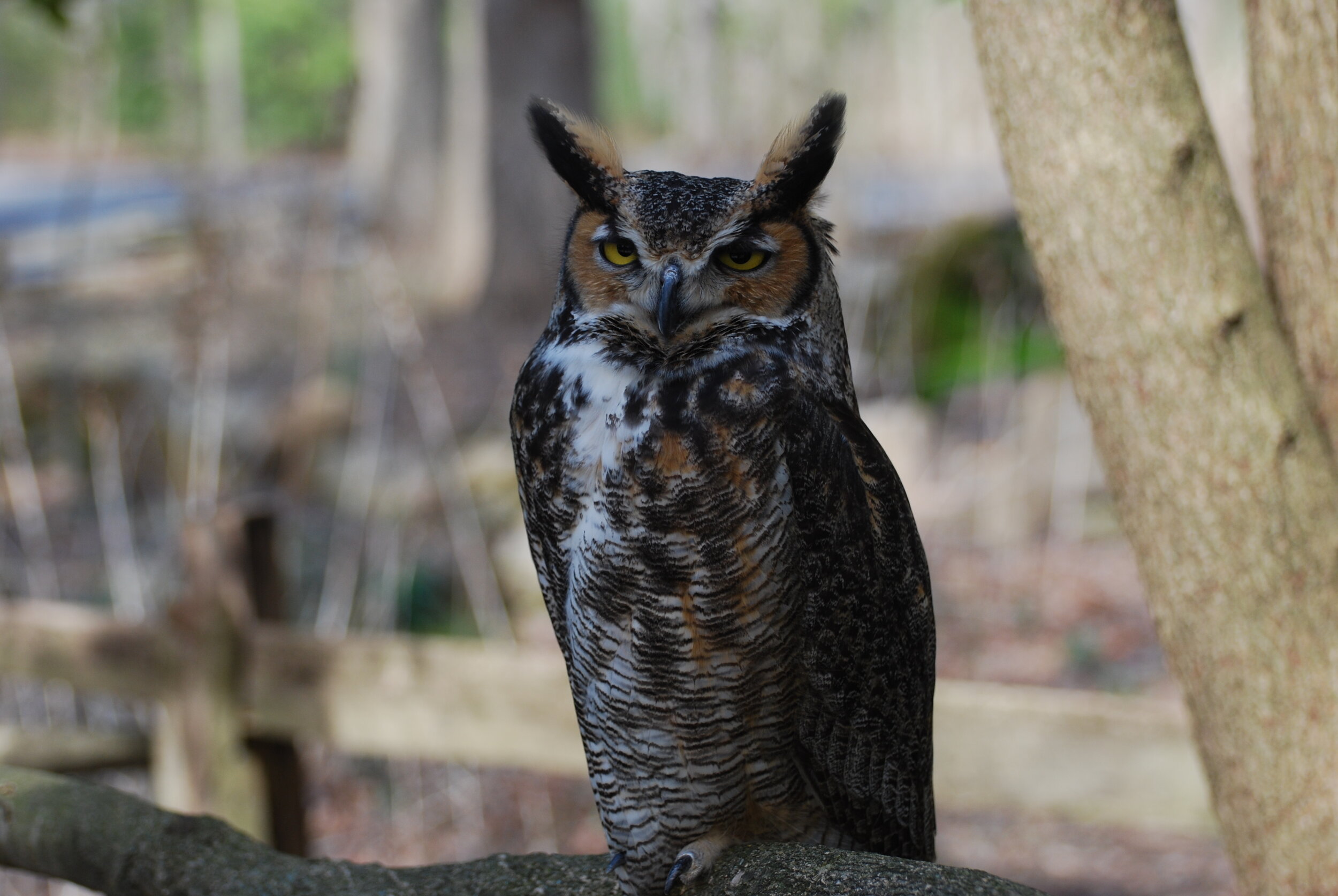What Owl is That?
A great horned owl in the Native Animal Enclosure
As Reflection Riding’s Wildlife Director, I get asked a lot of animal questions — one of the most frequent is, “I have an owl that lives in my woods that I can hear and see, but I don’t know what kind it is.” That statement is usually followed by imitations of calls, descriptions of birds, stories, and locales. I’ve even had folks tell me they hear monkeys in their yard! We’ll get back to that one! The adjectives and phrases used include loud hoots, huge, size of a small plane, came out of nowhere, must have been 2-3’ tall, must have weighed 20lbs, really brown, really dark… One of the easiest things I can do is imitate an owl call or play one on my phone. That usually nails the ID. The inquiring person’s face develops a smile followed by a “Yes, that’s it!” conclusion. Ahhh, success!
The most common owls in our neck of East Tennessee are the eastern screech owl, barn owl, barred owl, and great horned owl. Reflection Riding has all of these species in their animal ambassador collection. Some can be seen when you visit the Native Animal Exhibit and some reside off-exhibit.
The app I use on my phone is Sibley eGuide to Birds. There’s a full version and a free version. Sibley is considered by some to be THE bird guide. I also use the Cornell Lab Merlin app. The website I like the most is Cornell’s All About Birds; it’s a comprehensive, user-friendly resource. Check out TWRA’s website Watchable Wildlife, too. You’ll find audio so you can hear a call as well as photos or renderings to help with visual ID.
This little guy may only weigh four ounces, but he compensates with attitude!
The smallest tufted owl in our woods is the eastern screech owl, weighing in at 4 oz and packing a HUGE attitude (think Napolean). If you’re one of the smallest guys in the woods, you’ve got to be tough or get eaten! Many times, this bird is mistaken for a baby great horned owl — I can assure you that if the screech owl could speak, he would vehemently defend his age! A loud whinny and trill come from this small bird. I am often serenaded at night by one in my backyard. It’s a beautiful call! You might see either the gray or red color morph of this species. In my opinion, the gray morph has the best camouflage of all the native raptors and looks just like tree bark.
The barn owl — aka monkey-faced owl, heart-faced owl, or ghost owl — is listed “under management concern” in Tennessee and endangered in nearby states. You just don’t see this magnificently beautiful and unusual bird very often in our area. The barn owl has a very prominent, heart-shaped, white facial disc that acts like a satellite dish bringing sound into its ultra-sensitive ears. Studies on this bird’s hearing have shown it can hear a mouse’s heartbeat 30 feet away. That’s superhero hearing! One cool fact about this very athletic mouser is its performance of a defensive dance called toe dusting. It will lower its head, shake back and forth, spread its wings, and let out a super loud screaming call. It’s enough to conjure up ideas of ghosts.
Who cooks for you, who cooks for you all! These would be the words put to the barred owl’s call. This round-faced, fairly large owl gets its name from the horizontal and vertical dark brown and white barring on its chest. This raptor’s call is very distinctive and the one I mimic the most garnering smiles of, “that’s it!” I love this call! Multiple barred owls calling together sounds like monkeys having a rockin’ time in the trees and definitely makes the novice nature enthusiast wonder what is partying in their woods! Even though owls are nocturnal, barred owls can often be heard and seen in the afternoon. They prefer to be near bodies of water. If you go on one of Reflection Riding Arboretum & Nature Center's Paddle by Moonlight trips, you will have a good chance to see and hear barred owls.
Looks like a barred owl, sounds like a monkey!
Large, magnificent, absolutely beautiful, and regal are just a few descriptions of the great horned owl. This king of the forest reigns supreme in our neck of the woods and has an attitude to go with its rank. Old-timers call this bird of prey the Hoot owl after its similar-sounding call. This raptor eats just about anything it wants to and goes just about anywhere it wants to. If an adult red-shouldered hawk and an adult great horned owl crossed territories, there would be a power struggle, otherwise, the great horned owl rules. Massive feet with four talons per foot pack a powerful wallop of strength up to 500 psi! This bird is also equipped with silent flight and is often called the tiger of the sky.
To get more familiar with these incredible raptors, visit Reflection Riding and check out the websites and apps I mentioned, then go out at night and use your newfound knowledge to identify your avian neighbors! You can begin an owl conversation by imitating calls or answering calls — see if you can bring one in closer!




